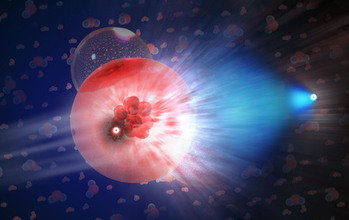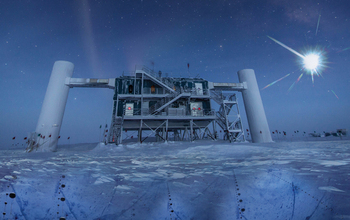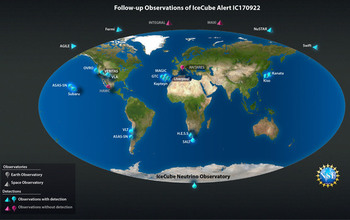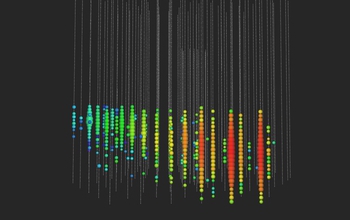All Images
News Release 18-050
Neutrino observation points to one source of high-energy cosmic rays
Collaborative scientific research using data from NSF's IceCube Neutrino Observatory in Antarctica helps answer century-old astrophysics question
This material is available primarily for archival purposes. Telephone numbers or other contact information may be out of date; please see current contact information at media contacts.
On Sept. 22, 2017, NSF's IceCube Neutrino Observatory alerted the international astronomy community that a high-energy neutrino had passed through the Earth. That notification set in motion follow-on observations from nearly two dozen observatories on Earth and in space, ultimately confirming the source of the neutrino, a first for science. This brief video explains the discovery and how it has helped resolve a 100-year mystery about the sources of high-energy cosmic rays.
Credit: NSF
Shown in this animation, a neutrino that has traveled across space from a blazar, enters the ice of Antarctica. Just before reaching the IceCube detector, the neutrino collides with an atom's nucleus, resulting in a muon particle. The muon continues through the deep ice and emits blue light which is detected by the photosensors in IceCube.
Credit: Nicolle R. Fuller/NSF

A neutrino, having interacted with a molecule of ice, produces a secondary particle -- a muon --that moves at relativistic speed in the ice, leaving a trace of blue light behind it.
Credit: Nicolle R. Fuller/NSF/IceCube
Download the high-resolution JPG version of the image. (1.8 MB)
Use your mouse to right-click (Mac users may need to Ctrl-click) the link above and choose the option that will save the file or target to your computer.

When a neutrino interacts in the clear Antarctic ice, it produces secondary particles that leave a trace of blue light as they travel through NSF’s IceCube detector.
Credit: Nicolle R. Fuller/NSF/IceCube
Download the high-resolution JPG version of the image. (1.4 MB)
Use your mouse to right-click (Mac users may need to Ctrl-click) the link above and choose the option that will save the file or target to your computer.

In this artistic composition, based on a real image of the IceCube Lab at the South Pole, a distant source emits neutrinos that are detected below the ice by IceCube sensors, called DOMs.
Credit: IceCube/NSF
Download the high-resolution JPG version of the image. (4.0 MB)
Use your mouse to right-click (Mac users may need to Ctrl-click) the link above and choose the option that will save the file or target to your computer.

On Sept. 22, 2017, NSF’s IceCube Neutrino Observatory alerted the international astronomy community about the detection of a high-energy neutrino. Approximately 20 observatories on Earth and in space made follow-up observations, which allowed identification of what scientists deem to be a source of very high energy neutrinos, and thus, of cosmic rays. Besides neutrinos, the observations made across the electromagnetic spectrum included gamma-rays, X-rays, and optical and radio radiation. The observatories are operated by international teams involving a total of more than 1,000 scientists supported by funding agencies in countries around the world.
Credit: Nicolle R. Fuller/NSF/IceCube
Download the high-resolution JPG version of the image. (787.3 KB)
Use your mouse to right-click (Mac users may need to Ctrl-click) the link above and choose the option that will save the file or target to your computer.

This is a high-energy neutrino detected by IceCube on Sept. 22, 2017. With an estimated energy of 290 tera electron volts (TeV), this was the 10th alert of this type sent by IceCube to the international astronomy community and launched a series of multi-messenger observations that allowed the identification of the first source of high-energy neutrinos and cosmic rays.
The neutrino event display shows a muon, created by the interaction of a neutrino with the ice very close to IceCube, which leaves a track of light while crossing the detector. In this display, the light collected by each sensor is shown with a colored sphere. The color gradient, from red to green/blue, shows the time sequence.
Credit: IceCube Collaboration
Download the high-resolution JPG version of the image. (653.5 KB)
Use your mouse to right-click (Mac users may need to Ctrl-click) the link above and choose the option that will save the file or target to your computer.
